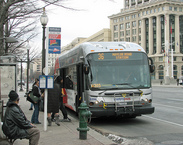Consolidate bus stops to speed up the 30s line

Photo by Beechwood Photography on Flickr.
Metro should consolidate bus stops on the 30s line to improve bus performance on Wisconsin and Pennsylvania Avenues. Metro streamlined other lines to stop no more than 4 or 5 times per mile, but the 30s line can stop as much as 9 times per mile.
Alternatively, Metro could convert some local buses into express buses during peak hours. This option could give Metro more flexibility to meet peak demand. These buses could follow a predetermined express schedule so riders would know which stops the bus would serve.
Currently, the 30s routes serves 9 stops on the 1 mile stretch between the Friendship Heights and Tenleytown stations. Similarly, there are 9 stops on the mile-long stretch from the Tenleytown to the National Cathedral.
The buses are particularly slow through Georgetown, where the avenue narrows to one lane in each direction. There are 7 stops on the mile-long route on Wisconsin Avenue from R Street to 28th Street. The bus also stops 7 seven times downtown between 24th Street on Pennsylvania Avenue and Madison Place on H Street NW.
On many of these sections, there is a bus stop at every block for multiple blocks. The 30s stop at Dumbarton, P, Q, and R Streets in Georgetown and at both ends of Lafayette Park and 18th and 17th Streets downtown. More stops means slower trips, particularly during rush hour when crowded buses increase the probability of a passenger requesting each stop.
Metro removed some bus stops earlier this year to improve on-time performance, which lags below the 80% target level (page 25 of the PDF). However, some residents oppose these consolidations and Metro relented on many of them.
It’s certainly understandable that communities would want to preserve all of their bus stops. Frequency of stops makes riding the bus more convenient and riders don’t have to walk as far to reach the nearest one.
But more bus stops generally mean slower buses, which ultimately makes the bus less convenient. In certain places, removing a bus stop has little impact on the convenience of the bus. For example, do the 30s really need to stop at Jackson Place and Madison Place on either side of Lafayette Park? The park isn’t that big and this stretch of H Street is often cluttered with rush hour traffic and other buses.
Alternatively, WMATA could turn local buses into express buses when demand is high. A manager at either end of a line could designate a bus “express” during peak times when the route is particularly slow and the bus could easily flash between “32 Friendship Heights” and “Express,” for example, to alert riders. If WMATA published an express schedule, riders could know whether to take the express bus or wait for the local one.
WMATA does currently run an express bus on part of this route, the 37 line. This bus connects Friendship Heights with Archives, but does so via Massachusetts Avenue and Dupont Circle. While this route speeds up the connection for riders going downtown, it does not service Glover Park, Georgetown and Foggy Bottom, which are often slower parts of the route.
Turning a local 32 into an express 32, for example, would mean the bus continues to run the entirety of the Friendship Heights to Southern Avenue route. But this express service would service fewer stops with a high number of boardings. This way, riders in Glover Park and Georgetown could connect to the Blue and Orange lines at Foggy Bottom much faster.
This real-time change could be implemented soon without the need to create an entirely new express route like the S9 or X9 buses. Bus stop consolidation could take more time, but is ultimately necessary to reduce travel times.
